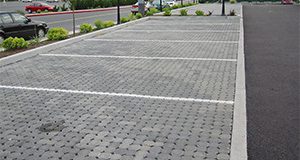Abstract
Permeable pavement systems are Green Stormwater Infrastructure practices that can reduce runoff while supporting vehicle and pedestrian traffic. This new 8-page document provides technical details of permeable pavement systems, such as application, system elements, design, installation, operation, maintenance, crediting, and costs, in order to inform planners, engineers, landscape architects, local government officials, and other professionals in the built environment about the considerations for implementing and maintaining permeable pavements. Written by E. Bean, M. Clark, and B. Larson, and published by the UF/IFAS Department of Agricultural and Biological Engineering, April 2019.
https://edis.ifas.ufl.edu/ae530
References
American Association of State Highway and Transportation Officials (AASHTO). 1993. AASHTO Guide for Design of Pavement Structures. 4th edition. Washington, D.C.: AASHTO. https://store.transportation.org/Item/CollectionDetail?ID=86
American Society of Civil Engineers (ASCE). 2015. Permeable Pavements. Reston, VA: ASCE Permeable Pavement Task Committee. http://www.asce.org/templates/publications-book-detail.aspx?id=15418
American Society of Landscape Architects (ASLA). 2018. "Professional Practice: The Sustainable Sites Initiative (SITES)." Accessed on March 26, 2019. https://www.asla.org/sites/
ASTM. 2015. "D1557-12e1 Standard test methods for laboratory compaction characteristics of soil using modified effort (56,000 ft-lbf/ft3 (2,700 kN-m/m3))." ASTM. Accessed on March 26, 2019. https://compass.astm.org/EDIT/html_annot.cgi?D1557+12e1
ASTM. 2017. "D448-12 Standard classification for sizes of aggregate for road and bridge construction." ASTM. Accessed on March 26, 2019. https://compass.astm.org/EDIT/html_annot.cgi?D448+12(2017)
Florida-Friendly Landscaping™ Program. 2018. Florida-Friendly Landscaping. Gainesville: University of Florida Institute of Food and Agricultural Sciences. https://ffl.ifas.ufl.edu/
Florida Green Building Coalition (FGBC). 2018. Florida Green Building Coalition. Accessed on March 26, 2019. http://floridagreenbuilding.org/
Interlocking Concrete Pavement Institute (ICPI). 2018. "Education." ICPI. Accessed on March 26, 2019. https://www.icpi.org/education-certification/education
National Association of Home Builders (NAHB). 2015. "ICC 700 National Green Building Standard™." NAHB. Accessed on March 26, 2019. https://www.nahb.org/research/sustainability/icc-700-national-green-building-standard.aspx
National Ready Mixed Concrete Association (NRMCA). 2018. "Pervious Concrete Contractor Certification Program." NRMCA. Accessed on March 26, 2019. https://www.nrmca.org/Education/Certifications/Pervious_Contractor.htm
National Cooperative Highway Research Program (NCHRP). 2004. "Chapter 3. Design of New and Reconstructed Flexible Pavements." In Guide for Mechanistic-Empirical Design of New and Rehabilitated Pavement Structures, Part 3: Design Analysis. Champaign, IL: National Research Council, Transportation Research Board, NCHRP. http://onlinepubs.trb.org/onlinepubs/archive/mepdg/Part3_Chapter3_FlexibleDesign.pdf
U.S. Green Building Council (USGBC). 2018. "Leadership I Energy & Environmental Design (LEED)." USGBC. Accessed on March 26, 2019. http://leed.usgbc.org/
Unless otherwise specified, articles published in the EDIS journal after January 1, 2024 are licensed under a Creative Commons Attribution-NonCommercial-NoDerivs 4.0 International (CC BY-NC-ND 4.0) license.

